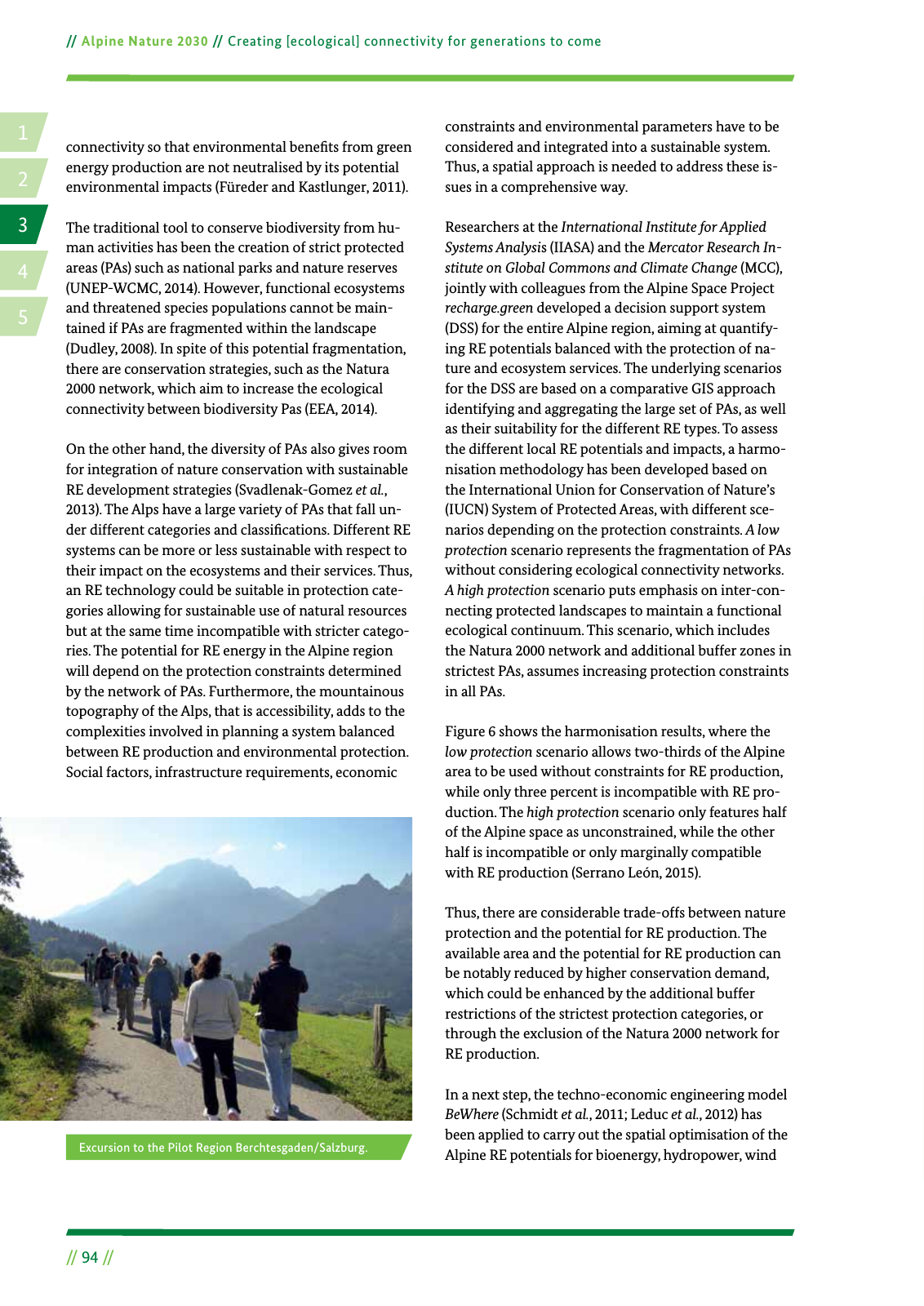14 2 5 3 Alpine Nature 2030 Creating ecological connectivity for generations to come 94 connectivity so that environmental bene ts from green energy production are not neutralised by its potential environmental impacts Füreder and Kastlunger 2011 The traditional tool to conserve biodiversity from hu man activities has been the creation of strict protected areas PAs such as national parks and nature reserves UNEP WCMC 2014 However functional ecosystems and threatened species populations cannot be main tained if PAs are fragmented within the landscape Dudley 2008 In spite of this potential fragmentation there are conservation strategies such as the Natura 2000 network which aim to increase the ecological connectivity between biodiversity Pas EEA 2014 On the other hand the diversity of PAs also gives room for integration of nature conservation with sustainable RE development strategies Svadlenak Gomez et al 2013 The Alps have a large variety of PAs that fall un der different categories and classi cations Different RE systems can be more or less sustainable with respect to their impact on the ecosystems and their services Thus an RE technology could be suitable in protection cate gories allowing for sustainable use of natural resources but at the same time incompatible with stricter catego ries The potential for RE energy in the Alpine region will depend on the protection constraints determined by the network of PAs Furthermore the mountainous topography of the Alps that is accessibility adds to the complexities involved in planning a system balanced between RE production and environmental protection Social factors infrastructure requirements economic constraints and environmental parameters have to be considered and integrated into a sustainable system Thus a spatial approach is needed to address these is sues in a comprehensive way Researchers at the International Institute for Applied Systems Analysis IIASA and the Mercator Research In stitute on Global Commons and Climate Change MCC jointly with colleagues from the Alpine Space Project recharge green developed a decision support system DSS for the entire Alpine region aiming at quantify ing RE potentials balanced with the protection of na ture and ecosystem services The underlying scenarios for the DSS are based on a comparative GIS approach identifying and aggregating the large set of PAs as well as their suitability for the different RE types To assess the different local RE potentials and impacts a harmo nisation methodology has been developed based on the International Union for Conservation of Nature s IUCN System of Protected Areas with different sce narios depending on the protection constraints A low protection scenario represents the fragmentation of PAs without considering ecological connectivity networks A high protection scenario puts emphasis on inter con necting protected landscapes to maintain a functional ecological continuum This scenario which includes the Natura 2000 network and additional buffer zones in strictest PAs assumes increasing protection constraints in all PAs Figure 6 shows the harmonisation results where the low protection scenario allows two thirds of the Alpine area to be used without constraints for RE production while only three percent is incompatible with RE pro duction The high protection scenario only features half of the Alpine space as unconstrained while the other half is incompatible or only marginally compatible with RE production Serrano León 2015 Thus there are considerable trade offs between nature protection and the potential for RE production The available area and the potential for RE production can be notably reduced by higher conservation demand which could be enhanced by the additional buffer restrictions of the strictest protection categories or through the exclusion of the Natura 2000 network for RE production In a next step the techno economic engineering model BeWhere Schmidt et al 2011 Leduc et al 2012 has been applied to carry out the spatial optimisation of the Alpine RE potentials for bioenergy hydropower wind Excursion to the Pilot Region Berchtesgaden Salzburg

Hinweis: Dies ist eine maschinenlesbare No-Flash Ansicht.
Klicken Sie hier um zur Online-Version zu gelangen.
Klicken Sie hier um zur Online-Version zu gelangen.